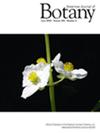High-intensity light promotes adaptive divergence of photosynthetic traits between sun-exposed and shaded populations in Saxifraga fortunei
Abstract
Premise
Light is essential for plants, and local populations exhibit adaptive photosynthetic traits depending on their habitats. Although plastic responses in morphological and/or physiological characteristics to different light intensities are well known, adaptive divergence with genetic variation remains to be explored. This study focused on Saxifraga fortunei (Saxifragaceae) growing in sun-exposed and shaded habitats.
Methods
We measured the leaf anatomical structure and photosynthetic rate of plants grown in their natural habitats and in a common greenhouse (high- and low-intensity light experimental sites). To assess differences in ecophysiological tolerance to high-intensity light between the sun and shade types, we evaluated the level of photoinhibition of photosystem II and the leaf mortality rate under high-intensity light conditions. In addition, population genetic analysis was conducted to investigate phylogenetic origins.
Results
Clear phenotypic differences were found between the sun and shade types despite their recent phylogenetic origin. The leaf anatomical structure and photosynthetic rate showed plastic changes in response to growing conditions. Moreover, the sun type had a well-developed palisade parenchyma and a higher photosynthetic rate, which were genetically fixed, and a lower level of photoinhibition under high-intensity light.
Conclusions
Our findings demonstrate that light intensity is a selective pressure that can rapidly promote phenotypic divergence between the sun and shade types. While phenotypic changes in multiple photosynthetic traits were plastic, genetic divergence in specific traits related to adaptation to high-intensity light would be fundamental for ecotypic divergence to different light regimes.

 求助内容:
求助内容: 应助结果提醒方式:
应助结果提醒方式:


